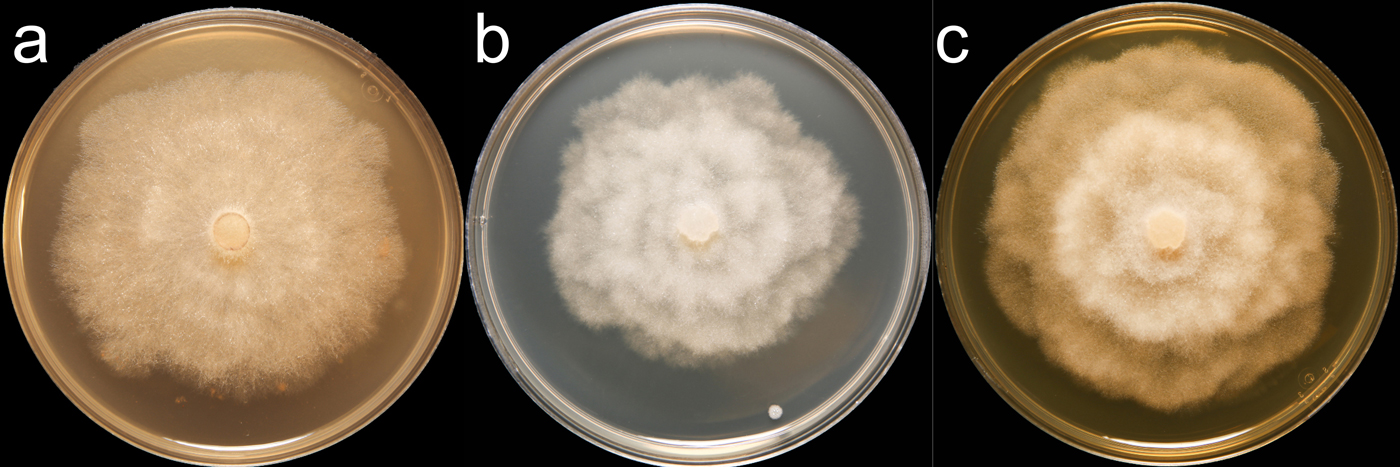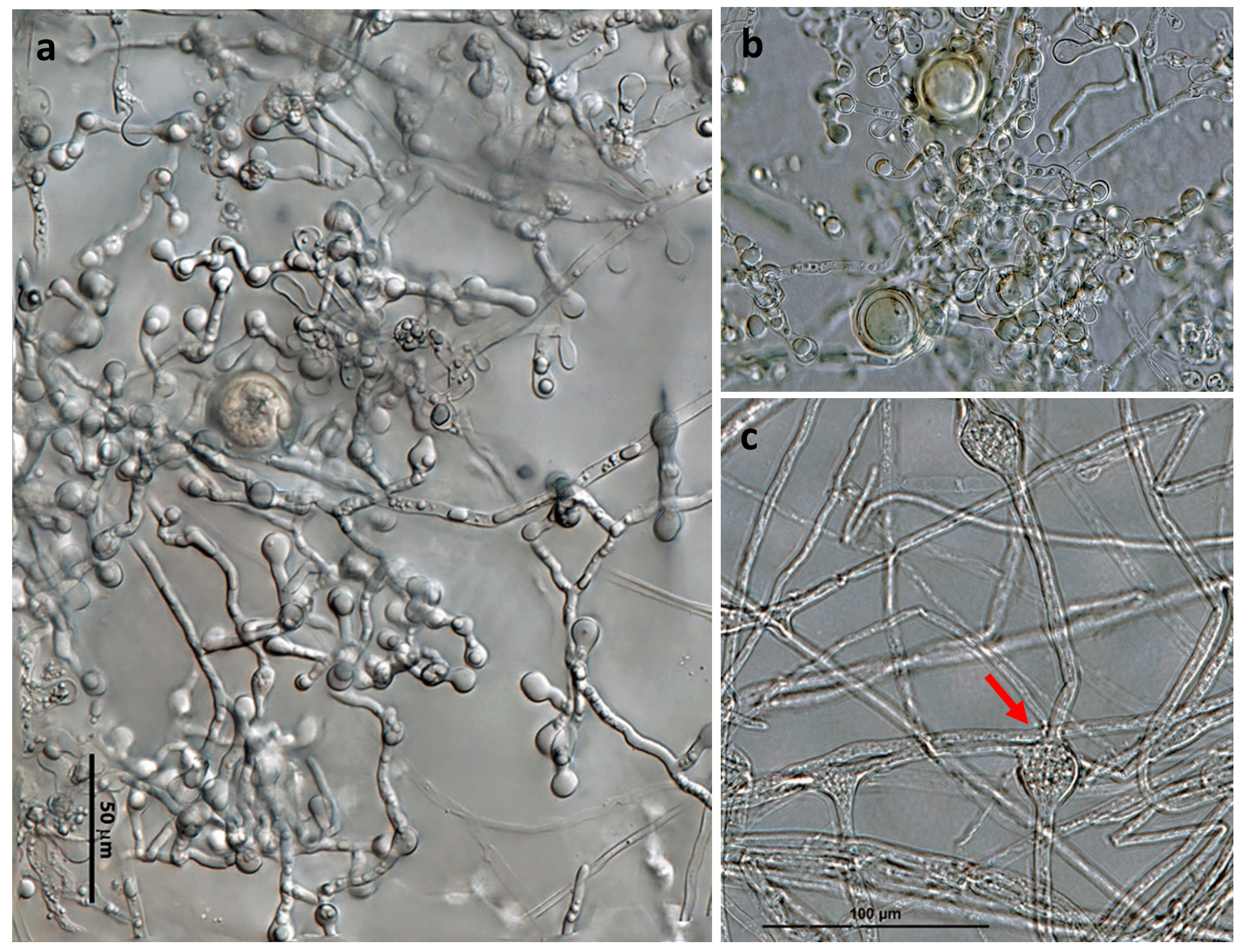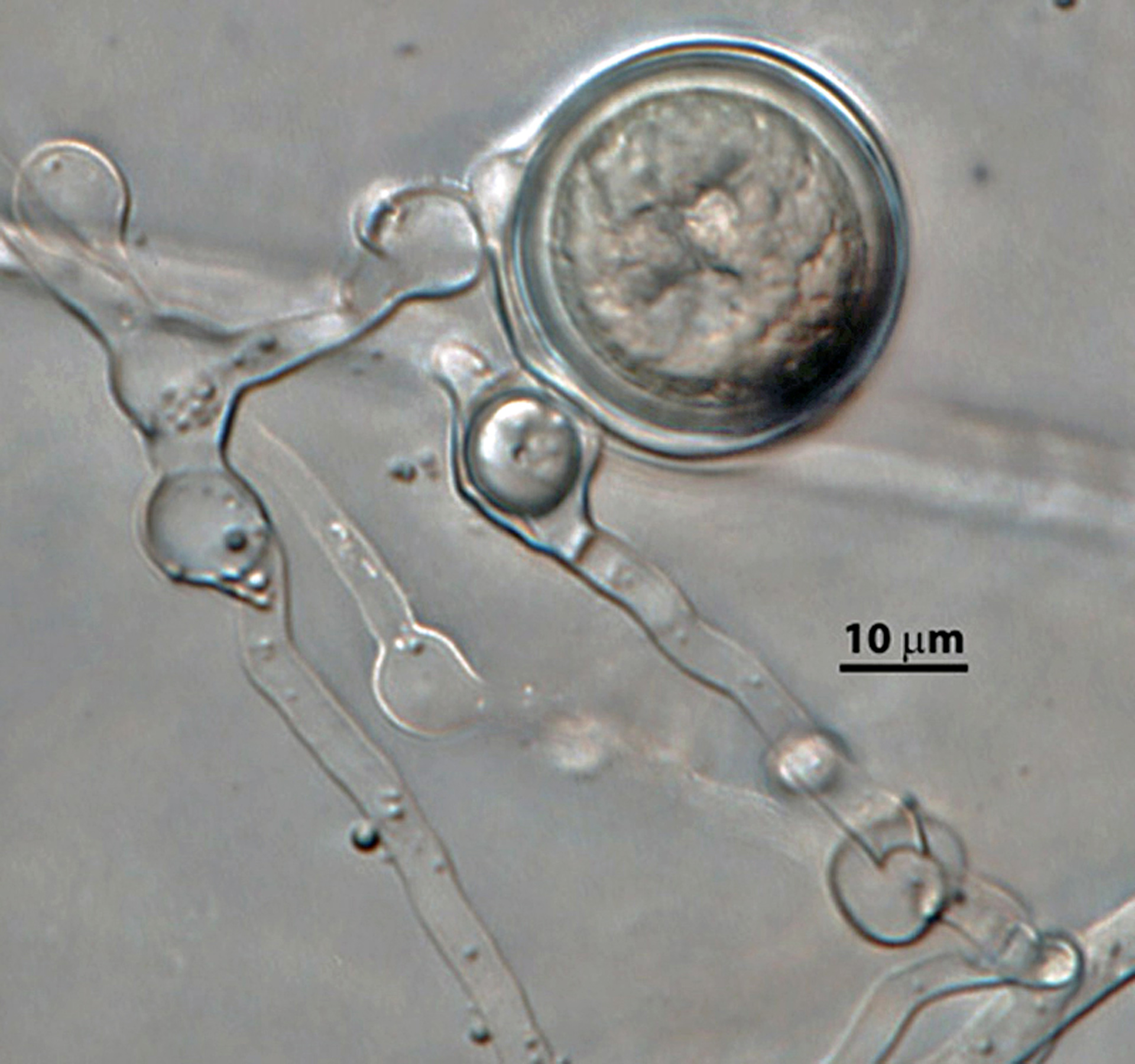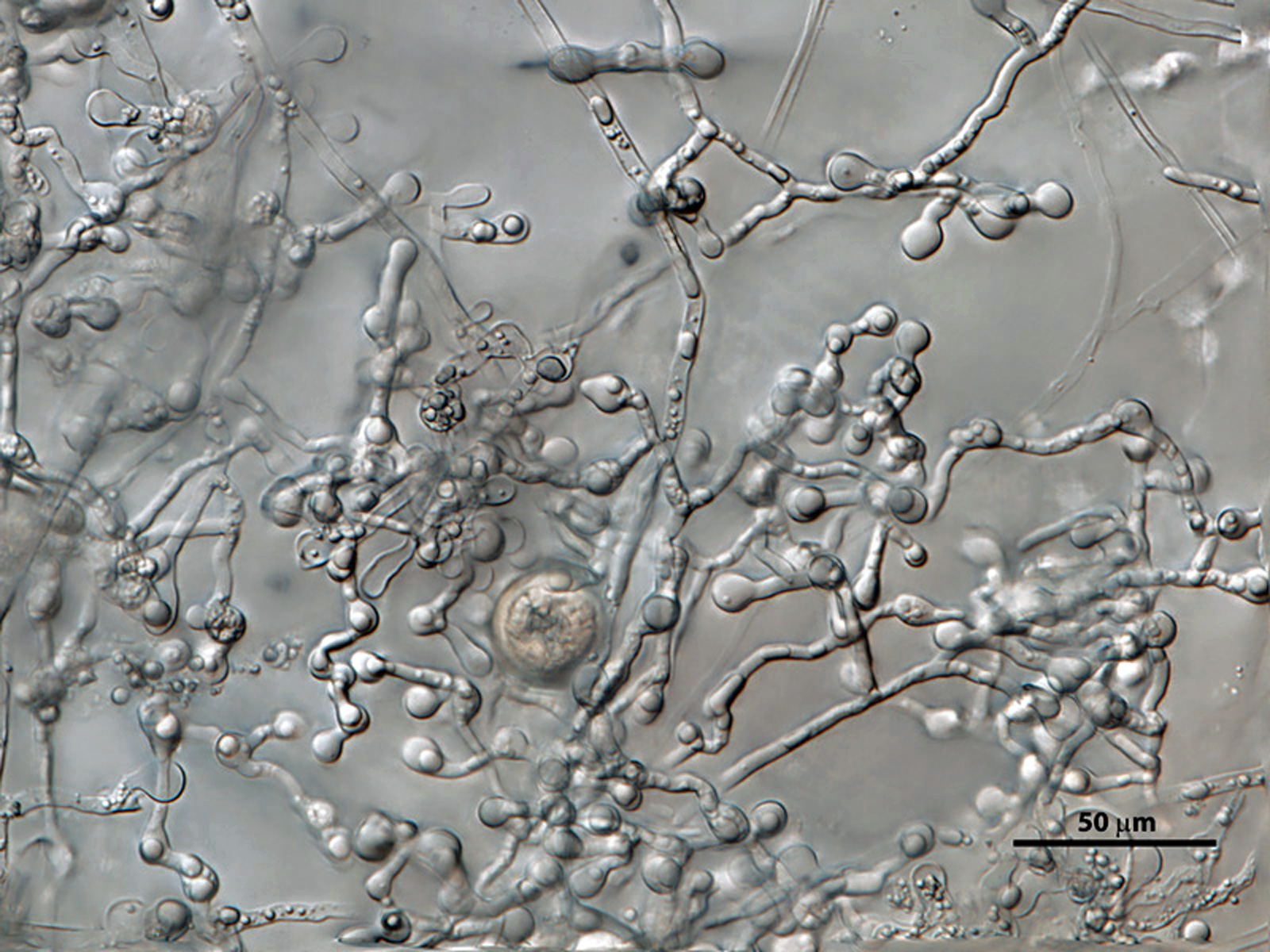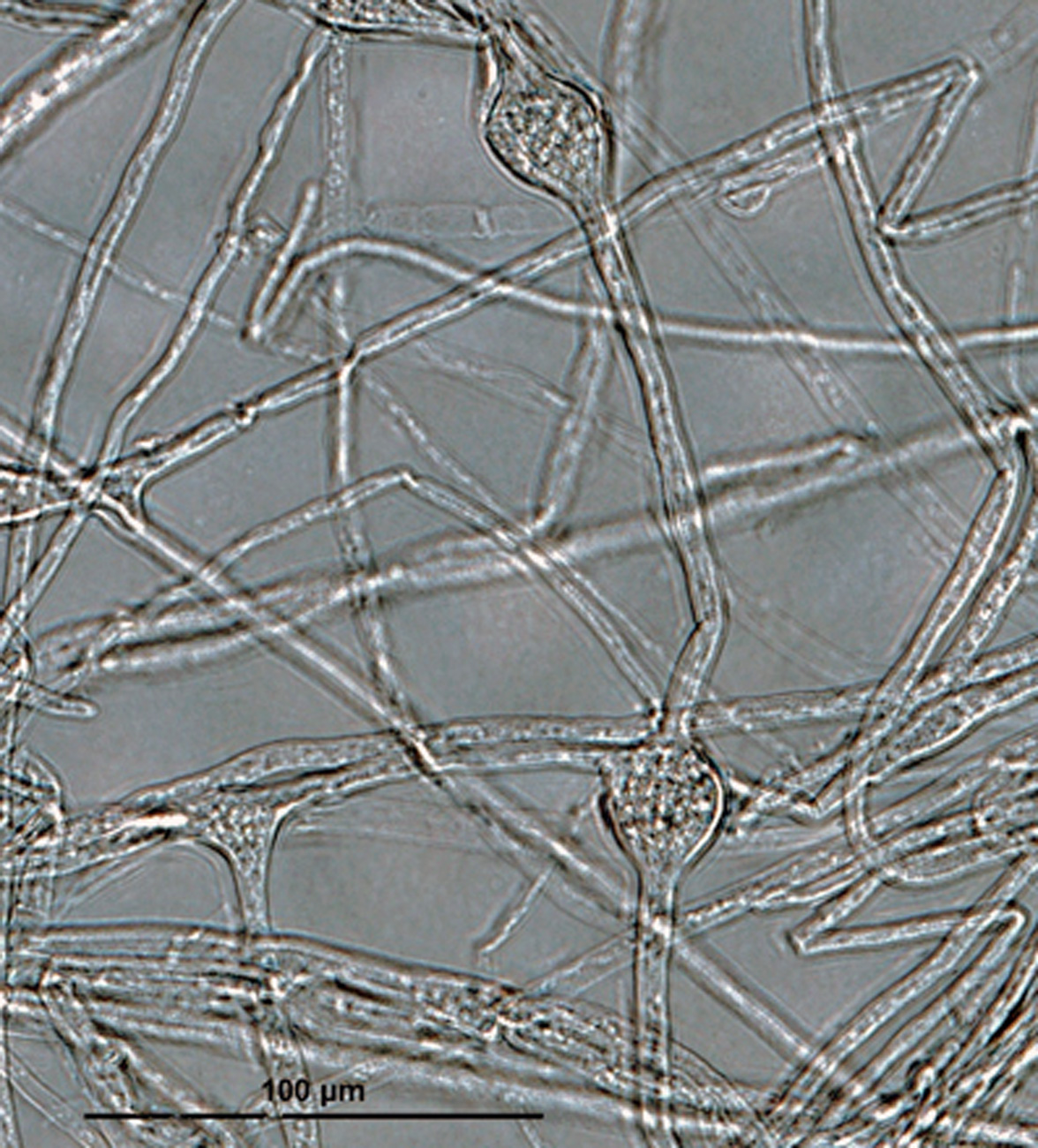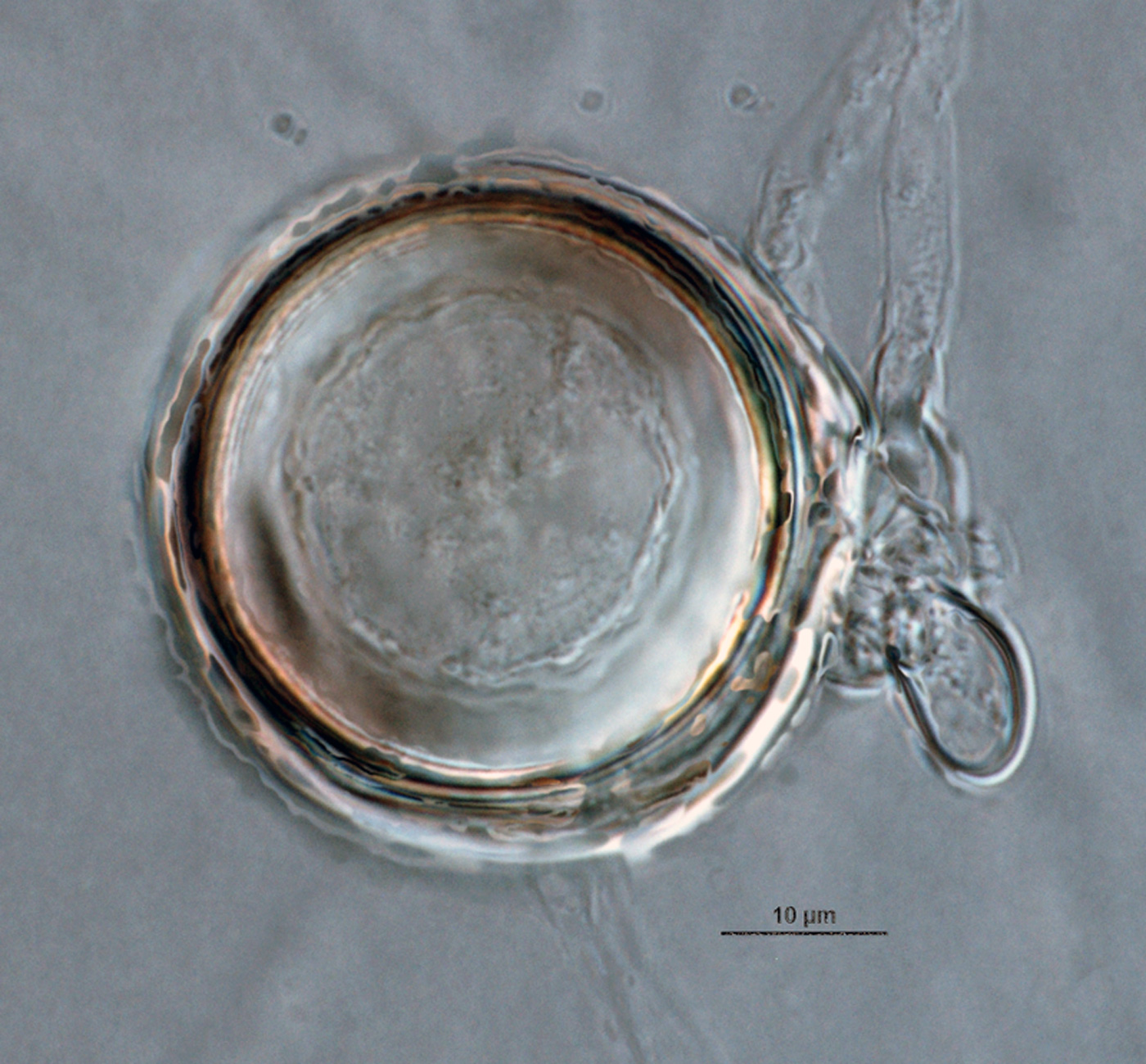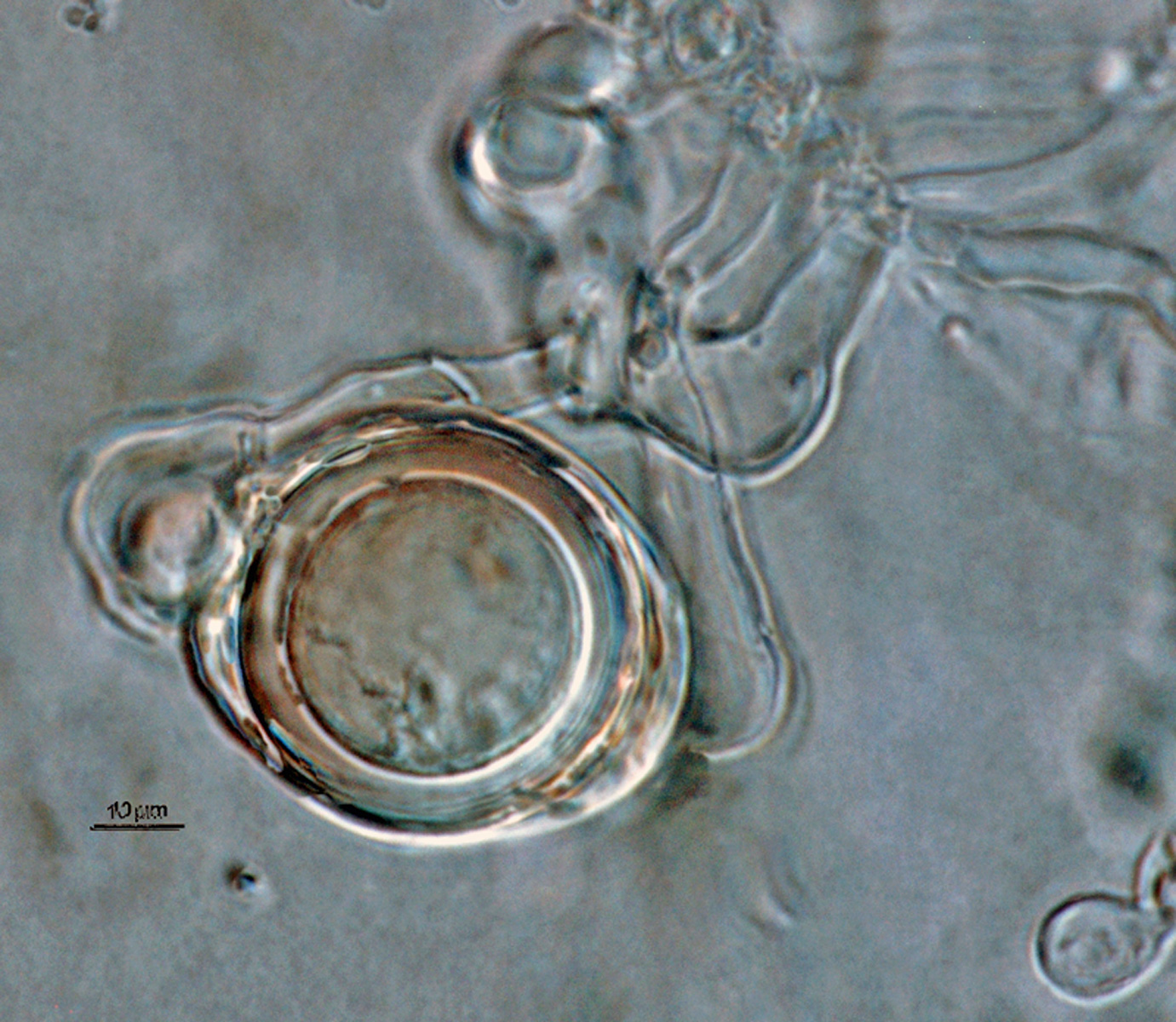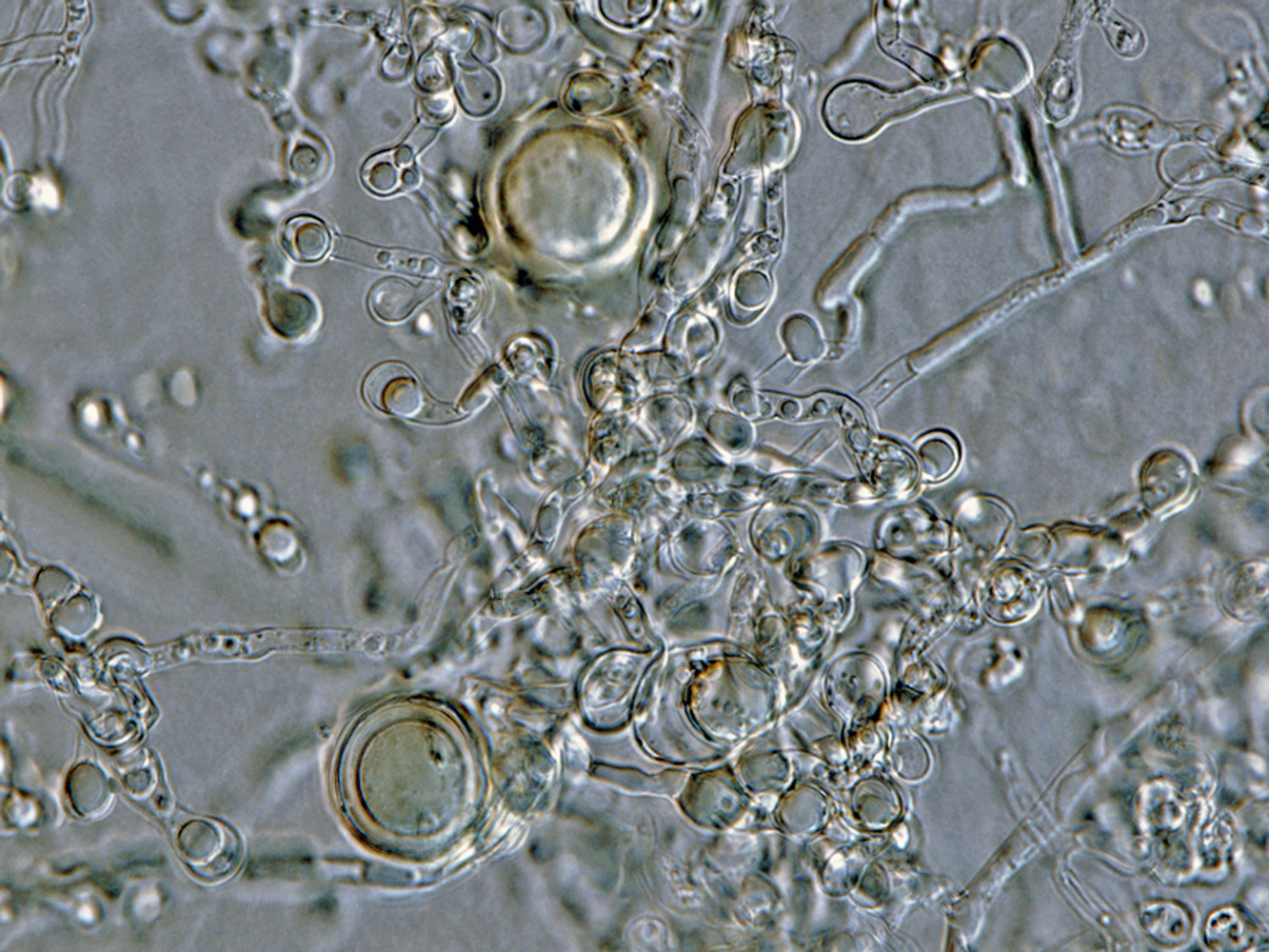Phytophthora humicola
|
Phytophthora spp. in subclade 6a: portion of the seven-loci ML phylogeny featuring the type cultures of 212 described species (by T. Bourret). Notice the position of P. humicola Ex-type CBS 200.81 = S&T BL 42G. Gloria Abad, USDA S&T.
|
|
Phytophthora spp. in subclade 6a: Morphological Tabular key (PDF) and Tabular key legends (PDF) in IDphy2 KEY SECTION. Notice the data of P. humicola Ex-type CBS 200.81 = S&T BL 42G. Gloria Abad, USDA S&T.
|
|
Phytophthora humicola (CPHST-BL 42G) colonies of the ex-type grown for 7 days on (a) V8® Agar, (b) potato dextrose agar, and (c) malt extract agar; photo by Krysta Jennings and Leandra Knight, USDA-APHIS-PPQ |
|
Phytophthora humicola (ex-type CPHST BL 42G) sexual phase (a–d): (a, b) oogonia smooth-walled with two long paragynous antheridial stalks, plerotic (a) and slightly aplerotic (b) oospores, in (a) antheridium in bottom showing digitated projection; (c) oogonium with paragynous antheridia; (d) oogonium with amphigynous antheridium and slightly aplerotic oospore; photos by Gloria Abad, USDA-APHIS-PPQ. |
|
Phytophthora humicola (ex-type CPHST BL 42G) sexual phase: (a, b) toruloid mycelia and oospores; (c) hyphal swellings with radiating hyphae; photos by Gloria Abad, USDA-APHIS-PPQ. |
|
Phytophthora humicola (ex-type CPHST BL 42G) sexual phase: toruloid mycelia and oospore; photos by Gloria Abad, USDA-APHIS-PPQ. |
|
Phytophthora humicola (ex-type CPHST BL 42G) sexual phase: toruloid mycelia and oospores; photos by Gloria Abad, USDA-APHIS-PPQ. |
|
Phytophthora humicola (ex-type CPHST BL 42G) sexual phase: oogonium smooth-walled with amphigynous antheridium and plerotic oospore; photo by Gloria Abad, USDA-APHIS-PPQ. |
|
Phytophthora humicola (ex-type CPHST BL 42G) asexual phase: hyphal swellings with radiating hyphae; photo by Gloria Abad, USDA-APHIS-PPQ. |
|
Phytophthora humicola (ex-type CPHST BL 42G) sexual phase: oogonium smooth-walled with paragynous antheridium and plerotic oospore; photo by Gloria Abad, USDA-APHIS-PPQ. |
|
Phytophthora humicola (ex-type CPHST BL 42G) sexual phase: oogonium smooth-walled with two long paragynous antheridial stalks and plerotic oospore; photo by Gloria Abad, USDA-APHIS-PPQ. |
|
Phytophthora humicola (ex-type CPHST BL 42G) sexual phase: toruloid mycelia and oospores; photos by Gloria Abad, USDA-APHIS-PPQ. |
Name and publication
Phytophthora humicola W.H. Ko & Ann (1985)
Ko WH and Ann JP. 1985. Phytophthora humicola, a new species from soil of a citrus orchard in Taiwan. Mycologia 77: 631–636.
Nomenclature
from Ko and Ann (1985)
Mycobank
Etymology
Latin, humicola (soil inhabiting), referring to the native environment from where the type was found
Typification
Type: TAIWAN, from soil, citrus grove, TAI 9017, dried culture preserved at Herbarium of Department of Botany, National Taiwan University, Taipei
Ex-type: CBS 200.81 (and ATCC 52179)
Ex-type in other collections
(ET) CBS 200.81, NRRL 64256, ATCC 52179 (MCI), CABI IMI302303 (PA), WPC P3826, IFO 32771, S&T BL 42G (Abad), 32F8 (Hong), p198 (Gallegly)
Molecular identification
Voucher sequences for barcoding genes (ITS rDNA and COI) of the ex-type (see Molecular protocols page)
Phytophthora humicola isolate CPHST BL 42G (= P3826) ITS rDNA MK496519, COI MK493476
Voucher sequences for Molecular Toolbox with seven genes (ITS, β-tub, COI, EF1α, HSP90, L10, and YPT1
(see Molecular protocols page) (In Progress)
Voucher sequences for Metabarcoding High-throughput Sequencing (HTS) Technologies [Molecular Operational Taxonomic Unit (MOTU)]
(see Molecular protocols page) (In Progress)
Sequences with multiple genes for ex-type in other sources
- NCBI: Phytophthora humicola CPHST BL 42G
- NCBI: Phytophthora humicola P3826
- NCBI: Phytophthora humicola CBS 200.81
- EPPO-Q-bank: Phytophthora humicola CBS 200.81
- BOLDSYSTEMS: Phytophthora humicola OOMYA038.07 (COI-5P:680, ITS:815) = CBS 200.81; OOMYA516.08 (ITS:2296); = CBS 200.81; PHYTO177-10 (COI-5P:680, ITS:816) = P3826 (barcoding COI & ITS)
Position in multigenic phylogeny with 7 genes (ITS, β-tub, COI, EF1α, HSP90, L10, and YPT1)
Clade clade:
a taxonomic group of organisms classified together on the basis of homologous features traced to a common ancestor
6a
Morphological identification
Colonies and cardinal temperatures
Colony colony:
assemblage of hyphae which usually develops form a single source and grows in a coordinated way
morphology after 7 days of growth on V8-A, PDA, and MEA with light petaloid pattern. The minimum temperature for growth is 9°C, optimum 28–30°C, and maximum 32°C.
Conditions for growth and sporulation
Sporangia are formed in nonsterile soil extract, and hyphal swellings are produced in sterile distilled water.
Asexual phase
SporangiaSporangia:
sac within which zoospores form, especially when water is cooled to about 10°C below ambient temperature; in solid substrates, sporangia usually germinate by germ tubes
nonpapillatenonpapillate:
pertaining to the production of a non-distinct, or inconspicuous, papilla at the distal end of the sporangium (cf. papillate and semipapillate)
; persistentpersistent:
pertaining to sporangia that remain attached to the sporangiophore and do not separate or detach easily (cf. caducous)
; ovoidovoid:
egg-shaped, with the widest part at the base of the sporangium and the narrow part at the apex
, obpyriformobpyriform:
inversely pear-shaped, i.e. with the widest part at the point of attachment (cf. pyriform)
(36–72 L x 30–52 W µm); presenting internal proliferationinternal proliferation:
internal proliferation occurs when the sporangiophore continues to grow through an empty sporangium
and sometimes with external proliferationexternal proliferation:
formation of a sporangium after a sporangiophore has emerged from beneath and external to an empty sporangium that has previously emitted its zoospores (cf. internal proliferation)
; some sporangiasporangia:
sac within which zoospores form, especially when water is cooled to about 10°C below ambient temperature; in solid substrates, sporangia usually germinate by germ tubes
with basal swellings; originated from unbranched sporangiophores and sometimes on the tips of hyphaehyphae:
single, tubular filament of a fungal or oomycete thallus; the basic structural unit of a fungus or oomycete
radiating from germinating hyphal swellings. Hyphal swellings large, spherical (22–56 µm diam) with radiating hyphaehyphae:
single, tubular filament of a fungal or oomycete thallus; the basic structural unit of a fungus or oomycete
, sometimes the dominant hyphahypha:
single, tubular filament of a fungal or oomycete thallus; the basic structural unit of a fungus or oomycete
produces another hyphal swellinghyphal swelling:
globular swelling that forms at a branch point or within the mycelium, by definition not separated from the coenocytic mycelium by a septum (cf. chlamydospore)
and forms a chain of hyphal swellings. ChlamydosporesChlamydospores:
an asexual spore with a thickened inner wall that is delimited from the mycelium by a septum; may be terminal or intercalary, and survives for long periods in soil
absent.
Sexual phase
Homothallic. OogoniaOogonia:
the female gametangium in which the oospore forms after fertilization by the antheridium
smooth-walled; spherical (21–49 µm diam) with long oogonial stalks; antheridiaantheridia:
the male gametangium; a multinucleate, swollen hyphal tip affixed firmly to the wall of the female gametangium (the oogonium)
paragynousparagynous:
pertaining to the sexual stage in which the antheridium is attached to the side of the oogonium (cf. amphigynous)
and amphigynousamphigynous:
pertaining to the sexual stage in which the antheridium completely surrounds the stalk of the oogonium (cf. paragynous)
, short cylindrical, spherical, ellipsoidellipsoid:
refers to a solid body that forms an ellipse in the longitudinal plane and a circle in cross section; many fungal spores are ellipsoidal or elliptic
or ovoidovoid:
egg-shaped, with the widest part at the base of the sporangium and the narrow part at the apex
, and irregular shapes (9–16 µm W), some with digitate projections, and some oogoniaoogonia:
the female gametangium in which the oospore forms after fertilization by the antheridium
with 2 or more antheridia; oopores apleroticaplerotic:
pertaining to a mature oospore that does not fill the oogonium; i.e. there is room left between the oospore wall and oogonium wall (cf. plerotic)
or slightly apleroticaplerotic:
pertaining to a mature oospore that does not fill the oogonium; i.e. there is room left between the oospore wall and oogonium wall (cf. plerotic)
(16–41 µm diam).
Most typical characters
Phytophthora humicola is characterized by the long stalks of the oogoniaoogonia:
the female gametangium in which the oospore forms after fertilization by the antheridium
and antheridiaantheridia:
the male gametangium; a multinucleate, swollen hyphal tip affixed firmly to the wall of the female gametangium (the oogonium)
and by the shape of the hyphal swellings.
Specimen(s) evaluated
Phytophthora humicola ex-type CPHST BL 42G, duplicate of P3826 (World Phytophthora Collection), which is a duplicate of ex-type CBS 200.81
Hosts and distribution
Distribution: Asia (Taiwan, type), Europe
Substrate: soil; able to infect fruits, roots, leaves
Disease note: Pathogenic to apple and cucumber, but not orange or eggplant, after wound inoculation.
Hosts: Citrus spp., soil. Natural host unknown, but isolated from a Citrus sp. orchard (Rutaceae). Inoculated hosts include Malus domestica (apple, Rosaceae) and Cucumis sativus (cucumber, Cucurbitaceae).
Retrieved January 31, 2018 from U.S. National Fungus Collections Nomenclature Database.
Additional references and links
Ginetti B, Uccello A, Bracalini M, Ragazzi A, Jung T, and Moricca S. 2012. Root rot and dieback of Pinus pinea caused by Phytophthora humicola in Tuscany, central Italy. Plant Disease 96 (11): 1694. DOI: 10.1094/PDIS-05-12-0451-PDN.
Ko WH and Ann PJ. 1985. Phytophthora humicola, a new species from soil of a citrus orchard in Taiwan. Mycologia 77 (4): 631–636.
- SMML USDA-ARS: Phytophthora humicola
- EPPO Global Database: Phytophthora humicola
- Forest Phytophthoras of the World: Phytophthora humicola
- CABI Digital Library: Phytophthora humicola
- Encyclopedia of Life (EOL): Phytophthora humicola
- Index Fungorum (IF): Phytophthora humicola
- Google All Phytophthora humicola
- Google Images Phytophthora humicola
- Google Scholar Phytophthora humicola
Fact sheet author
Z. Gloria Abad, Ph.D., USDA-APHIS-PPQ-S&T Plant Pathogen Confirmatory Diagnostics Laboratory (PPCDL), United States of America.

